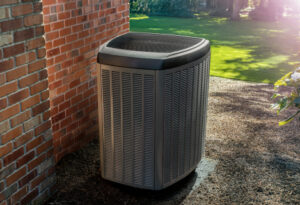
Smart sustainability isn’t one size fits all. It wouldn’t be smart if it were. Each situation, each house, and each family are different. And each budget. So how do you decide what are the smart sustainable decisions for you? It’s a process. I recently went through this process for our family’s heating and cooling system, and here’s what it looked like for us.
Our furnace was due to be replaced soon and I didn’t want to have to pick a new system in a rush when it broke, so I called a consultant to start looking at our options. I’d already made some efficiency upgrades, starting with a blower door test and then adding caulking, attic insulation, spray foam in my basement rim joists, and a chimney cap that seals the fireplace flue from outside. I’d also switched our electricity supplier to one that provides 100% renewable power.* Still, I was surprised when my consultant suggested that the house was efficient enough to go off fossil fuels completely with an air-source heat pump.
I was excited about the idea of using only renewable energy to power our home, but the idea of a house with gas service available and no gas furnace was hard to get used to. Sure, I thought for a house built from the ground up for exceptional efficiency it would be easy and very practical to go all electric. And I’ve recommended all electric ground source heat pump systems for houses in the country with no gas available. But was this really a practical decision for our 1959 ranch in the city? Would we end up regretting it when we got our heating bills? Would it make more sense to get a less efficient heating system and spend the savings on more insulation?
We had modeling to compare the initial and operating cost of several solutions, but we had to make many other decisions about what was important to us before those comparisons could be useful. We were concerned about comfort, indoor air quality, and risks from carbon monoxide, so the system we selected needed to address those as well as efficiency. If we used a gas furnace, we wanted the safety and efficiency of sealed combustion. We also wanted the comfort of a variable speed fan. I was happy to go to an induction cooktop, so I wouldn’t

have to worry about creating indoor pollution every time I made tea. We wanted to get a heat pump rather than a simple air conditioner, so we could heat the house with renewables in the spring and fall. I was surprised to learn that eliminating the gas furnace could reduce the initial cost of the system, and that stopping the gas service would save us their monthly base fee.
With all these considerations, it became clear that going all electric made sense.
It was a smart decision. What made it smart was that we took the time to evaluate the options and consider all the factors from cost to comfort, rather than just replacing the old equipment with something similar. We considered what made sense for our individual house and family, rather than using a one-size-fits all solution. It took some extra effort, but making a smart sustainable decision was worth it.* To switch your electricity to 100% renewable power, visit Energy Choice Ohio and under the Residential heading choose your electricity provider (Ohio Edison, AEP, etc.). In the search bar at the left, choose “Renewable Content, 100%” and then click on “Filter Results”. The resulting chart will list the available plans with 100% renewable content.
